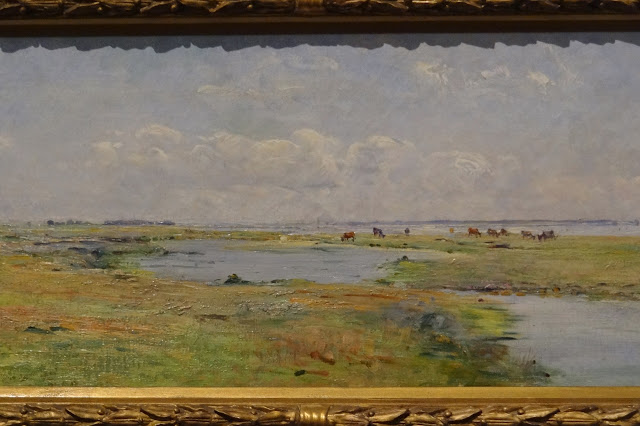A couple of weeks ago I posted a piece on Ai
Weiwei’s exhibition in Helsinki (here). I thought I might as well bring out
another great retrospective we saw a few months back in Tallinn, Estonia.
This was a show of the Swedish artist Hilma af Klint (1862-1944) whose pioneering
abstract paintings were only discovered decades after her death. What’s more, her first abstract pieces were made several years earlier than those of
Kandisky, Mondrian and Malevich who were always considered the fathers of
modern abstract art. A stunning revelation about an isolated female artist of
the early 20th century, don’t you think?
Hilma af Klint’s extraordinary art comes, in
a way, from the other end of the scale than that of Ai’s. She devoted her energy
to pursuing the spiritual, to describing those aspects of human existence that
cannot be seen, the relationship between humanity and the universe even.
Besides spiritualism, she was drawn to theosophy and anthroposophy, the contemporary
movements her male ‘counterparts’ were also affected by.
Having studied at the Swedish Royal Academy
of Arts, Hilma af Klint mastered the naturalist style painting landscapes and
portraits for her living. In the late 1890s, she started to attend spiritual
meetings with four female friends. The group calling themselves ‘The Five’
documented the séances in notebooks and experienced what they called automatic
writing and drawing. The group kept the ‘output’ to themselves.
Hilma af Klint believed she was acting as a
medium receiving messages from higher powers. Between 1906 and 1915, she
created the core of her oeuvre, the Paintings
for the Temple. It comprised 193 works in various series that she believed
she was channelled to paint for a ‘temple’. According to herself, the first
series Premordial Chaos (above) from 1906 was
brought about without her conscious effort, for example. The ‘temple’ was never
built. It is now believed the temple didn’t refer to a building but should rather
be considered a metaphor for spiritual evolution.
The most fabulous series of her Paintings
for the Temple is the one called The Ten
Largest created in 1907. They depict the four phases of human life:
childhood, youth, adulthood and old age. Eight of the ten were leading you to
the Tallinn show taking your breath away.
 |
| From right: Nos 1 and 2, Childhood; Nos 3 and 4, Youth. |
 |
| From left: Nos 7 and 6, Adulthood; No 4, Youth. |
 |
| From right: Nos 9 and 10, Old Age. |
 |
| Altarpieces. |
The exhibition included more than 200 works
some of which had never been on display before. I found some of them – in the
Evolution series mostly – if not disturbing at least unpleasant to look at and
took very few photos of them. Those are just the ones I should have shot
because I found there are very few photos of those available on the Internet. There were also several later series of smaller abstract and
geometric paintings as well as delicate studies and watercolours of plants on display.
Hilma af Klint was convinced the public would
not understand her spiritual works of art and noted in her will they cannot be shown
in public until at least 20 years after her time. Having never married she left
everything to her nephew. In the 1970s, the collection of more than 1000 works
and some 125 notebooks was offered to the Moderna Museet, the Museum of Modern
Art, in Stockholm. The management declined on the grounds that they had never
been exhibited and were therefore not part of the art scene. It was only in the early 1980s that her art was disclosed for the first time in a Nordic conference in Helsinki.
Some pieces were finally put on display in Los Angeles in 1986.
The exhibition we visited at the Art Museum of Estonia KUMU was entitled ‘Hilma af Klint: A Pioneer in Abstraction’.
It was organised by none other than the Moderna Museet as a tribute to one
of the greatest Swedish artists. The show was first seen in Stockholm in 2013.
From there it has been touring Europe until very recently: Berlin, Málaga, Humlebaek,
Helsinki (for such a short period in 2014 we didn’t see it there), Tallinn, and
late last year Oslo.
Incidentally, Hilma af
Klint is also very topical in London. The Serpentine Gallery in Kensington Gardens will exhibit, if I have understood
correctly, a smaller-scale show of her art from March 3 to May 15. Her
mysterious and radical creations from a hundred years ago are still startlingly
‘modern’ as if they had been made today.
This post in linked to ‘Paint Monthly’ on the Coastal Ripples blog.
This post in linked to ‘Paint Monthly’ on the Coastal Ripples blog.





















What a wonderful exhibition. It would be great if you posted a link on this months Paint Monthly for others to see. Barbara x
ReplyDeleteThank you very much for letting me know about this!
DeleteKiitos tästä näyttlyesittelystä. Hilma af Klint on ollut upea oman tiensä kulkija taiteilijana ja naisena. Noista teoksista huokuu hyvää mieltä.
ReplyDeleteNuo kymmenen suurinta olivat aivan maagisen hienoja! Ne oli ihan pakko käydä kiertämässä näyttelyn lopuksikin.
DeleteGosh, she produced some really beautiful work didn't she! Such a shame that it has taken so long to be exhibited and recognised. Happy valentines! xx
ReplyDeleteShe truly was one of a kind and probably right when keeping her unconventional works hidden considering they were not accepted to the art museum even in the 1970s. That was a crying shame!
DeleteShe was truly a woman ahead of her time. Wonderful to see these extraordinary paintings - so great that they are finally coming to light. A shame that art needs certain protocol to be accepted. So many artists were never appreciated during their lifetimes. Thank you for sharing these. - Karen
ReplyDeleteI am happy you enjoyed the post, Karen.
Delete